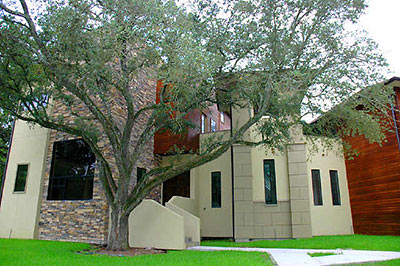
Why oh why won’t anyone buy this Timbergrove Manor pleasure palace? A Swamplot reader writes in to note that the 6,000-sq.-ft., 5-bedroom home at 6204 Queenswood Ln. — “the biggest house by far in Timbergrove” — endured a rather dramatic price cut recently.
The home has been listed since last August — presumably during construction — for a whopping $1.8 million. As of late April, though, it’s been available for just $1 million! That’s a reduction of about two neighboring houses!
***
It’s tall, too. Here you can see the home towering over nearby palm trees:
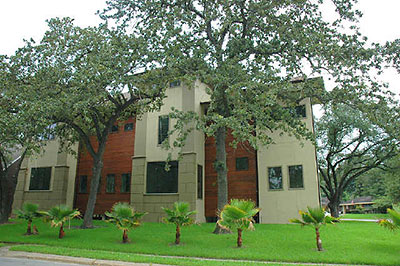
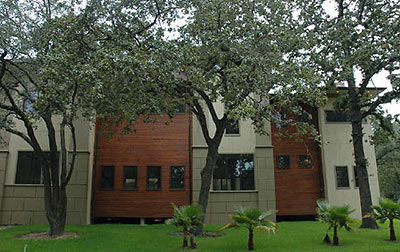
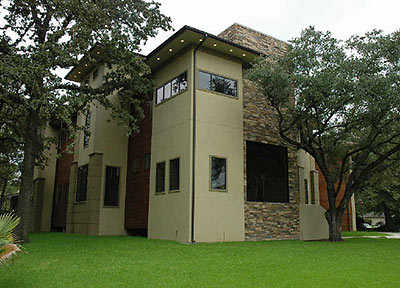
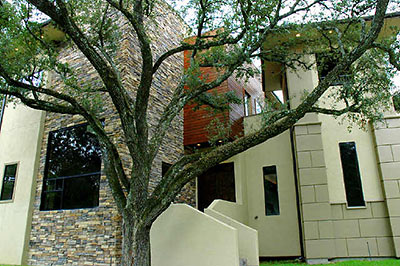

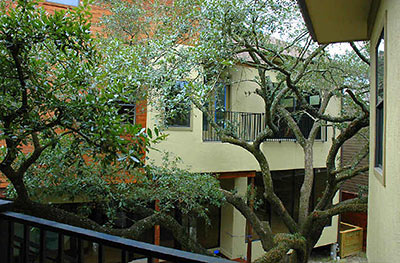
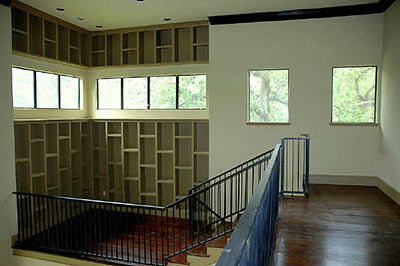
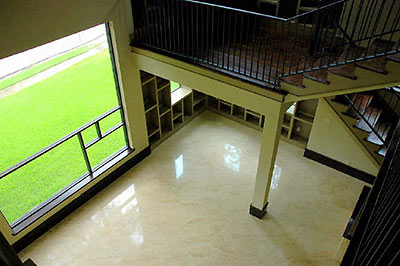
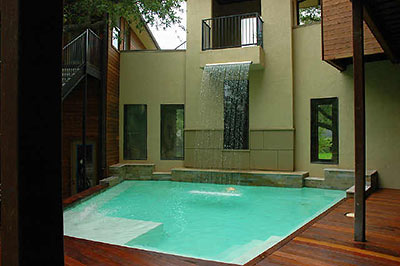
- 6204 Queenswood Ln. [HAR]


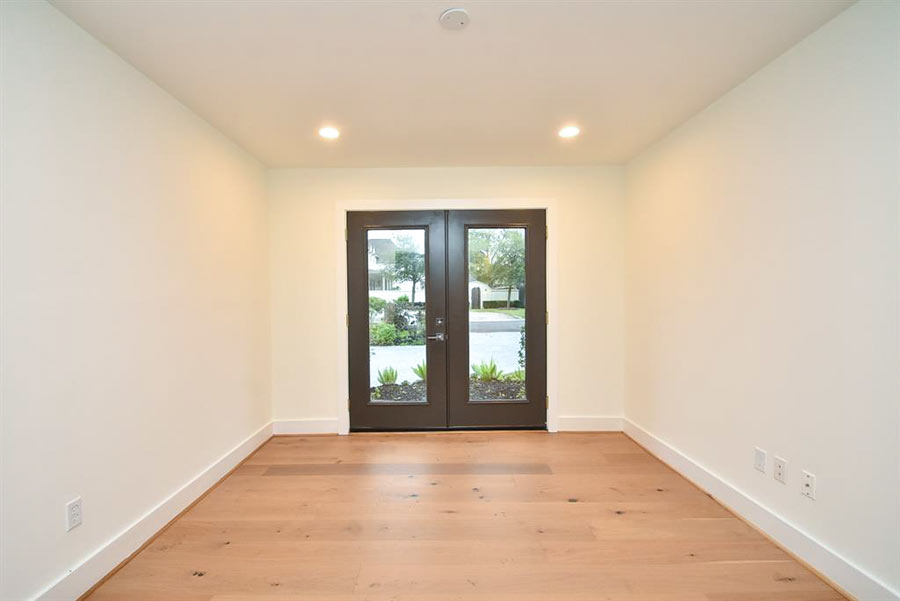


Beautiful, yet way too much.
I like how the trees still have presence over the house.
yikes…talk about overbuilding for a neighborhood.
I was told by a neighbor that the builder’s wife really liked the neighborhood and encouraged her husband to build his monstrosities there. I believe he has a similar looking but much smaller listing just down the street. It may have sold by this point though.
That is one fugly house.
Nice price cut for a fugly house. This give something to look forward to these builders of another mcmansion in bellaire: http://search.har.com/engine/dispSearch.cfm?mlnum=78061634 – 1.9 mil for what? :)
from the listing “The Wonderful front window was built using the Golden Ratio. ”
What is the golden ratio? Some architecture concept?
Those palm trees remind me of the stonehenge model from Spinal Tap. My guess is the landscaper order 18′ trees, but 18″ trees were delivered.
Maybe they can hire some garden gnomes to dance around them.
“The Golden Mean ratio and how the proportion 1 : 1.618034 was used in the Parthenon.”
I’ve never heard it referred to as the Golden Ratio.
Is this Pee Wee’s playhouse? It is way tooooooooooo bizarre and incredibly over scale for the area. I hope this bankrupts the builder.
Looking at the TSARP.org site, it’s in the 100 year floodplain and there seems to be a little branch of a bayou running pretty close by. Might be very easy to fill the pool. Also, there really is such a thing as wenge wood floors, who knew?
To Cosmo Topper
I am a very small custom builder. While I certainly know builders who have abused and gamed the system, and because I know them personally, wish them no good luck, it is assinine for someone like you to make a statement that you hope the builder of the Timbergrove Manor house goes broke. I doubt you know him or her, so you have no right making such a mean spirited statement.
As a very small builder who is just trying to come out the other side of this economic mess in one piece, your kind of comments make me see red.
In the mean spirited nature of yourself, heres hoping you loose your shirt and every last thing you own due to the recession.
Sorry but you deserve it for your idiotic comments.
I hope this bankrupts the builder.
___________________________________
Ya’ll can be pretty harsh on here sometimes! :)
total pee wee’s playhouse.
if it’s on the market for too long you might see it as a futuristic porno movie set for rent :)
Wenge wood is a rare wood from the rainforests of West Africa.
Perfect for the environmentally-conscious along with several rare woods from the Amazon rainforest – what are a couple of thousand trees? Especially when they make such lovely floors that the owners can then brag about. Particularly about how much they cost.
The house is a perfect example of what happens in a booming market. Some homes are inappropriate in terms of price for some neighborhoods. This is one of them.
As for the “fugliness” it seems to reflect a phenomenon seen all around the country. What the builder lacks in architetural aesthetics he or she makes up for with lots of expensive treatments. Some will buy them believing price is all that matters. “I own the most expensive house on the block.” Although I suspect this one still has some price reductions in its future. And still will be the most expensive house on the block. And probably the tackiest.
“Perfect for the environmentally-conscious along with several rare woods from the Amazon rainforest – what are a couple of thousand trees?”
Don’t perpetuate this myth. Particularly with the Amazon rain forests. The Amazon rain forest does have logging operations, but are very similar to the Canadian and US operations in the reality that more trees are planted in the end. The thing about a renewable resource and it being the basis for a business is that you need to keep it being renewed. The Brazilian government has policies in place to ensure reforestation from logging. Good thing.
The biggest threat to rain forest in the Amazon (particular in Brazil) is due to the extensive use of sugar cane based ethanol. Brazil has a strict energy independence stance where it drills for oil and makes up the difference in its needs with ethanol. Their success in ethanol production has made a profitable export (to the US mainly) while also satisfying their needs. The problem is that they need more farm land and they won’t replace food production farms with sugar cane farms. So they chop forest down for more farm land. So our demand for Ethanol is hurting Amazon rain forest. Our demand for exotic woods does not.
***steps of soap box and goes back to work***
This looks like the demo home for a siding contractor. Blech.
The Golden Ratio (Greek letter phi) is one of those weird irrational numbers (like pi & e). It solves the felicitous problem: if you have a line that’s (a+b) long, where do you divide it so that the ratio of a+b:a is the same as a:b? The answer is 0.6180339… along its length. If a is 1 unit long, and b is .6180339etc. long, the total length of a+b is phi, 1.618033…
We mathematicians love phi, because 1/phi = phi – 1. It’s just too wonderful.
However, all the happy wonderfulness of phi can’t possibly excuse this monstrosity! The ancient Greeks would have a fit at the perfect ratio of the Parthenon’s proportions being so painfully perverted.
To Cosmo Topper:
What a jerk you are for saying that about the builder. Your karma is about to suffer.
Have a great day.
I like this place actually. It really doesn’t quite fit the area, but I still like it save for a couple things here and there. I have some friends that used to live just down the street from here and my concerns about this location while it was being built was a) flooding, and b) train noise.
I am often dismayed by some of the mean spirited comments on this blog by posters. Most of us have had our share of unfortunate encounters with unscrupulous builders and developers, but there are good ones out there just like in every other industry. Everyone makes mistakes (apparently except for cosmo topper) and this house could very well be the builder’s biggest example of his most recent mistake. However, for people to publicly hope that this builder should lose everything is just classless. Some of the people posting on here are either suffering from real insecurity complexes, or are just plain not worth communicating with.
KJB’s right about the exotic woods. People should explore some real facts instead of manufactured propaganda before blindly buying into the BS that “greenies” espouse as “facts”.
The Amazon rain forest does have logging operations, but are very similar to the Canadian and US operations in the reality that more trees are planted in the end.
___________________________________________
Now. But they didn’t always. And replanting little trees doesn’t replace the big trees that provided what’s known as the canopy. And without the canopy there is no rainforest.
Sorry but there are too many other options for flooring to justify destroying the rainforests. I go nuts over it. I know two people who built “green” houses. And used exotic woods for flooring. Sort of calls into question the meaning of “green” if you ask me.
I do feel for the smaller builders because their homes are usually superior to the “tract housing” built by the “big boys” and of course their costs are sometimes much higher than the “big boys” and so their profit margin is less to begin with. I don’t wish bankruptcy on anyone although I would like to see more small builders building quality and architecturally aesthetic homes than what is offered by the “big boys.”
Ohhhh those awful, awful palm trees. In San Antonio we refer to that as the Abuelo Syndrome… when your grandpa comes to your new house and plants dwarfed palm trees along the street. KLASSY.
Matt,
You need to understand the destruction of rain forest acreage is due to increase agricultural demands not due to logging. The use of Brazilian hardwoods (such as Mahogany and Teak) for furniture and flooring as a mass produced item is a recent development when reforestation practices have bee put into place. Prior to that, the heavy deforestation was primarily due to soy bean and sugar cane production.
In recent years, Brazil has created through a permitting process reforestation link to farming. The reforestation is replanting more than what is being cleared on top of research from Brazilian universities to create more fast growing versions of the native hardwoods.
My primary point is that the logging industry in Brazil to create flooring, furniture and other wood based goods is not the culprit. So if anyone wants to purchase products based in these woods, they can be sure that they aren’t doing it to the expense of the rain forest. The logging industry in Brazil has done their part from the get go. Until recently, you couldn’t say that when buying ethanol based gasolines or soy bean products from Brazil. Also, most of our ethanol comes from Brazil since our ethanol development isn’t in full force in the US and businesses are realizing they can’t make any money in generating ethanol without a government subsidy.
I have other reasons against the use of ethanol in the US, but that is for another blog another day.
There are definitely small builders who provide service and quality with respect to the individual client price range.
Architecturally aesthetic homes are unfortunately always going to be in the eye of the beholder and as such not everybody will see the same beauty.
Also sorry for the strong reaction to cosmo topper before, but some defense of my sentiments no matter how indirect are appreciated by this builder.
Fugly? I don’t know how you can diss a house that is part castle, part tree house, and part lobby/ indoor pool area of an upscale Marriott? I would love to have this house! A five car garage? Awesome! 6,000+ square feet of pure, unadulterated rumpus room? A dream come true!
Honestly, I think this would be a fun home to own. You could let your inner child run free with reckless abandon. I just wonder about the upkeep on all the wood siding and “wenge” flooring. In my care, it would probably all look like driftwood in a few years.
Matt just likes to start trouble.
Diggity, yeah, and I end up suckered in to refute.
Wilf, if I could get a 1500-2000 sq-ft version of this house, I would love it. I like the style. I like that it’s not traditional.
Matt just likes to start trouble.
_________________________________
From coast to coast. Realtors read and wonder. And worry about Matt naming names.
Hey Matt! Go ahead. Name some names.
The use of Brazilian hardwoods (such as Mahogany and Teak) for furniture and flooring as a mass produced item is a recent development when reforestation practices have bee put into place. Prior to that, the heavy deforestation was primarily due to soy bean and sugar cane production.
_________________________________________
Mass production may be recent. But the demand is not and in great part the exotic Brazilian woods came into vogue in the 1970s as a result of DK Ludwig’s “Amazon Adventure” aka the Juri Project. Google away. He found the species of wood he intended to reforest with and use for pulp didn’t do well. So he started buying native rainforest wood which suddenly found a market although the real market was not for paper. It was in flooring and furniture. For those who could afford it and back then it was very expensive wood indeed and rarely seen outside of equally expensive homes in Rio de Janeiro and Sao Paulo and quite a few government buildings in Brasilia.
One problem Ludwig discovered which is still a problem is that new trees don’t do well in the Amazon because of the humidity, the bugs, and the various fungi. Some new growth manages to survive. Much of it doesn’t. You have to also consider the “fauna and flora” which no one does believing it doesn’t matter. It does but, well, what’s a couple of thousand ferns along with a couple of thousand trees?
As for the problem of deforestation for sugar cane plantations for ethanol production, that became a problem ten years ago. It was not a problem thirty years ago. Thirty years ago Brazil was just beginning to explore ethanol. And ethanol from sugar cane.
The real myth is that you can reforest a rainforest once you have deforested it. You cannot and the Brazilians know it and are trying to limit how much land can be deforested and how the land can be deforested and sugar can plantations threaten the rainforest because of the amount of land needed to be cleared. The preferred deforestation method is a “strip” deforestation which preserves an adjoining area of rainforest and so preserves an adjoining area of canopy. That’s not possible to do with sugar cane plantations. So of course the corporate interests who see lots of profit in sugar cane and the ethanol it produces have managed to convince the government that mass reforestation will work. It didn’t work for anyone else. It won’t work for them.
Blaming the problem on sugar cane plantations is fine. But the increased demand for exotic woods the past thirty years is also part of the problem. Added to the problem is the likelihood of oil exploration in the western regions of the Amazon.
The rainforests are our planet’s lungs. Some seem to feel otherwise. Hope they enjoy their fancy floors as they begin to gasp for air along with the planet.
I don’t think the house is ugly, per se, just out of scale and out of price for the neighborhood. Price points in Timbergrove did shoot up dramatically over a period of time, but, $1 million? Nah. Overpriced.
A coworker saw the post and said, “Look, they’ve got a Fibonacci window!”
You know, I love older, compact homes… and i can’t help it, I like this house. I don’t have a million to spend and I don’t want a giant house, but I can’t help but think, this thing is FUN!
Sorry. We all have our guilty pleasures.
And honestly, there’s something to be said for some variation in a pleasant but somewhat tedious and undistinguished area (in terms of architecture) like Timbergrove Manor. (I am not knocking the neighborhood, it’s just pretty bland in terms of the housing stock – but a good in-town place to live nonetheless.)
So did they forget some sheetrock near the stairs or is it supposed to look like that?
Not going to get involved in the Brazilian hardwoods debate but the Wenge species of tree is actually listed as endangered on the IUCN red list. Just think, it would be like walking on polar bears.
This looks to be interesting home but c’mon Realtor–these are the only pics posted on
http://www.har.com and the virtual tour is just the same pics put to music. Surely, there is something else inside this 6000 square foot home to entice your prospective buyer.
Not going to get involved in the Brazilian hardwoods debate but the Wenge species of tree is actually listed as endangered on the IUCN red list. Just think, it would be like walking on polar bears.
________________________________________
I didn’t know that. But it doesn’t surprise me. Of course to some, that will make them even more exotic. And more expensive. No doubt they are no longer cutting them down. They have an ample supply. Can’t do anything about the trees they’ve already cut down, now can they?
Until they become even more exotic and more expensive and they decide to just keep increasing the “existing inventory” via a black market. Which they may already be doing if it on a list.
Sort of like that head of the Siberian tiger on the wall. The one shot last year. And smuggled in. Listed on the lading as a bobcat.
I like that house except (for its size). I wish more developers and builders would try modern designs. I like the golden mean window as well.
What fun what fun!. The tangents alone are worth the price of admission.
I like it.. I like the modern design here and the attempt to being a little “edgy”.. As one that entertains often, the large spaces would be great..
I don’t think you’d make friends with your neighbours necessarily..
Note to Relator. More inside shots.. Where’s the kitchen? Where’s a bedroom? Where’s that great whirlpool tub?
I love the house, but I would love it somewhere with matching scale homes. Where it is I hate it. It looks like a big old sore thumb!
Just did the Google street view on this address. This builder should be tied and quartered.
EMME,
Really? Tied and quartered? Hope its an attempt at sarcasm.
Also, how can a neighborhood change if scales aren’t allowed to adjust?
Downtown couldn’t exist by that rule. many of the recent skyscrapers are built where single family and some multifamily homes existed.
The area where Minute Maid, GRB, Hilton Americas, and Toyota center was home to many large row houses similar to that of Boston. What if scales couldn’t change? Midtown could turn into the urban place many want it to be.
Just tossing out things to think about.
wcsjr,
I understand your dismay at our meanness. Many of us have had builders such as this one come into our lovely humble neighborhoods and build these monstrosities which changes the geography of all the surrounding homes, and kills our property values while forcing us to protest our increasing property taxes. We consider that to be pretty selfish and pretty mean. Please forgive us if sometimes we express that in a crass manner.
I personally am not opposed to responsible homebuilders, but this builder was not one I would put in that category. I would call this a predatory homebuilder. And yes, since he is going to negatively impact the property values of all those surrounding his house, bankruptcy seems a kind thing to wish on him. Kind of like Madoff, he is attempting to profit off of the backs of others.
Sorry if we hurt your feelings.
Who exactly is this particular home builder preying on? It seems like the only person getting burned is the builder himself.
I could be wrong, but haven’t property values in the Heights skyrocketed over the past several years? I would really like an example where property values have been getting “killed” in the Heights due to predatory building. As a general observer, it seems that property values (along with assessments) have drastically increased in conjunction with new development.
If you don’t want homebuilders coming in and changing the landscape of a neighborhood, then move to a deed-restricted neighborhood. You’ll have a better chance of maintaining your monotonous surroundings.
I live in a modest but marketable home. A homebuilder comes in and builds that home next to me. My home is now considered a teardown. Any improvements I may want to do to my home are now solely expenses, with no ability to recoup the cost of the upgrades.
More importantly, the reason that our property values are what they are is becaus the Heights is what it is. Predatory to me means, no care or concern for the long term wellbeing of the neighborhood. Just want to make a quick buck.
Lookit, these guys are building here because to build that house where it truly belongs is out of their range. DO a google street view and see what ALL the other homes within eyesight look like. The landscape has drastically changed. Any prospective homebuyers will see that and see the others as teardowns.
Won’t happen on my street. MLS and MLB has been submitted with 90% signature support of my heighbors.
Predators. If you don’t like the lable, change your methods.
My partner and I actually looked at this home a few weeks ago, before the price chop! Although over priced for the neighborhood, it had many features we were looking for in a new home. The home is being built by Flatiron, who I have always been a fan of. Their designs seem to combines traditional finishes in a modern fashion, creating a warm contemporary home. When I called to schedule the appointment, the listing agent indicated that the home had sustained water damage during Ike due to broken windows. She also let me know that the home would soon be going into a short sale, which is now listed on the Agent side of the MLS Listing. (I later found that other Flatiron properties, located at 1901 14 ½ St, had slipped into foreclosure.) Unfortunately, the home did suffer major damage, which in reality looked like the roof leaked throughout the house. The sheetrock has been removed from all ceilings and top ¾ of the walls on the entire second floor. All the molding has also been removed throughout the house. The floorplan is amazing with large rooms, wide hallways and high ceilings. It is really an amazing place!
EMME,
If you do improvements to your home to raise the price, then you are doing no different that this large home. Both are improvements to the existing property.
This house is just spending a lot more than the others might.
The thing about this particular part of Timbergrove is that most of the existing homes are in the floodplain (some are in the floodway) which makes selling a little harder other than just a teardown. The new homes of any size have to be built higher than existing ones anyway total changing the neighborhood. If the home is in the floodway, it can’t be sold unless done without a mortgage (all cash). Mortgage companies won’t give a loan to a home in the floodway that is not elevated because it can’t get flood insurance.
If I win Powerball, I’ll buy it to tear down and move an endangered old house there!
The pool is very relaxing-looking, but I’m not sure it would appeal to any family with teenagers wanting to take vacations without the kids. That balcony is just too tempting….
Hellsing, you make EMME laugh!
I sent this link to Gus. The house is nice and if money were no object it would not be a bad place to live. Really what bothers me about this house is how much different it is from the houses around it. As Emme said, look at google street view or better yet go drive by there. There are no other houses in all of Timbergrove I’ve seen listed for over $1M. Nothing even close to this house. The houses around it are all small 1950s homes. There are virtually no original homes in that section of Timbergrove that are bigger than 2000 sq feet. It sticks out like a sore thumb.
KJB: there is a big difference between my $200k improvement and that $1.9mm improvement. Big ‘ol sore thumb!
But in a free society, would want to restrict how much someone can spend on their property? What if I thought your $200k improvement was too much and you should keep the house the way it was originally built. Updating it would destroy the character of the house.
Where’s the line?
EMME, how can the building of larger homes both reduce your property value and increase your property taxes at the same time? If your real property value is dropping and your appraised value for taxation is increasing that is an issue to take up with the City, not with builders.
Jimbo,
Wouldn’t it be with HCAD.
The city has no bearing on property value for tax assessments.
May 31st is the last day to protest for anyone protesting.
If you have some knowledge of moving around HCAD’s website, you mostly likely can protest your property value yourself. They even let you electronically submit the protest now.
If you want someone else to do it, there are tons of firms set up to do just this. Even form Harris County Tax Assessor Paul Bettancourt has a firm to do this. Most don’t charge anything unless they lower your property taxes.
Also EMME, MLS and MLB would have absolutely no effect on the building of a similar home on your street if this lot existed there.
The setback is the same as the properties on either side of the new home. The lot size is 12,000 sq ft which would be well above your minimum lot size presumambly. In fact with a 6000 sq ft two story home on a 12,000 sq ft lot the footprint of the home will be about 25-30% of the total lot size. There are original bungalows on my street that occupy a greater percentage of there total lot area.
kjb, you’re absolutely right. Not engaging brain before typing again.
Well I’m guilty of that too!
But seriously people! Protest your property taxes!
If you are planning to live in your home for several years, then lowering the value of it is worth it since your aren’t planning to sell it to break even or profit soon.
kjb434: Where’s the line?
—–
The ‘line’ is where one’s “improvement” negatively affects the adjacent properties material value. An example would be where a house wiht a nice yard is surrounded by out-of-scales houses. The surrounding houses block the sun. The landscaping dies. The house no longer has a nice view of trees, or neighboring yard, but of the neighboring houses’ siding only inches away from the window. What was once perhaps a nice yard, nice views, and natural lighting from within a house are no longer marketable features but negatives. The yard is no longer nicely landscaped, but wasted but buildable space. Thus, reducing the exsting house to a ‘teardown’.
It’s an oft repeated cycle on blocks in the Heights and Rice Military. Though in RM that cycle is about over. Nothing left.
Property owners have rights to build at will on their property. But existing neighbors have rights to their own property’s value as well. As happens when you cramp people together we must be careful not to tread upon each other. It doesn’t take much consideration to do this. But a house like this shows NO consideration. And when builders show contempt; neighborhoods move toward restricting and regulating them. If builders want to avoid regulation – they should build with consideration of the surrounding site.
I would argue that the “line” is anything that is legally within a property owner’s rights. The minimum obligations you owe to your neighbors is to observe city ordinances and deed restrictions/neighboorhood association rules. That’s it. If someone wants to build a castle on his property, and it is done within the rules, then the neighbors have to live with it.
I’m not so sure what you mean when you say that “existing neighbors have rights to their own property’s value.” That comment is true to the extent to the amount you have control over your property value.
In areas like RM or the Heights, people have little control on external sources impacting their property. People do have a right to their property, but they don’t have a right to tell an adjacent homeowner what to do. I bet you the owners of the out-of-scale houses surrounding the small home can’t wait until that eyesore of a small home is demoed and redeveloped.
The bottom line is this. If you don’t like what’s happening around you, either move to an area which severely restricts development or take action to prevent this from happening to your neighborhood.
Thank you DMc for articulating much better what I was trying to say.
The only reason this is happening in the Heights and not in suburban neighborhoods is that we are not protected with deed restrictions. The line has been drawn in most neighborhoods.
And congratulate me – I submitted a complete MLS MLB petition this morning, so my street at least now has that protection going forward (pending outcome). My block has not been invaded as yet. We do have one contemporary home, but it was built by and for the occupant, within existing scale of the neighborhood, mature trees left standing and is a welcome addition to our street.
djc has it right.
Those protections some claim their older neighborhoods don’t have can be obtained. Many older neighborhoods have actively worked to obtain deed restrictions and done it successfully. It’s not impossible. If you really want it, it can get done.
Yes, the Houston Heights Association has deed restrictions which two of my neighbors have enacted on their properties. Now that I have the MLS MLB in place, that is my next project.
People do have a right to their property, but they don’t have a right to tell an adjacent homeowner what to do. I bet you the owners of the out-of-scale houses surrounding the small home can’t wait until that eyesore of a small home is demoed and redeveloped.
——
There’s the logic trap. Why do people in out-of-scale house get to impose *their* will upon the neighboring houses? Do they get the privledge because their house is newer? Or because bigger=better? Or because it’s tax assessment is higher? If we applied the same logic to driving .. Biggest, newest, and most expensive vehicle at the intersection wins! I’ll choose a new shiney tank, please.
One way or the other someones rights are going to be stepped on when something out-of-scale is proposed. It’s only a question of which party. What gives one more rights than the other?
Those are rhetorical questions above. I don’t have any answers other than most of the arguments never happen with proper siting, and in-scale development.
It’s unfortunate neighborhoods are being forced to resort to the long arm of regulation. It’s a result of builders that show no restraint. Builders are smart enough to figure out what ‘fits’ without resorting to regulation. But they don’t.
Neighborhoods in Houston are declaring themselves ‘historic’ not to keep progress from happening, or even preservation. But to keep out-of-scale development out. It’s the misuse of intent. Kinda like using a flatblade screwdriver on a phillips head screw. It’s the wrong tool. But it’s all we’ve got.
DMC,
You also have the problem of: If a scale is set somehow, how will a neighborhood ever change (especially if it gets run down)?
I brought up a few posts earlier about downtown. Much of modern downtown Houston skyscrapers were built to the west and south of the original older downtown buildings. The new area where the skyscrapers were built (especially to the south) was single family and some multifamily homes. We still see what’s left of that neighborhood before I-45 with the Antioch Church. If the rule of scale was in place, downtown would exist. What about Minute Maid Park, Toyota Center and the GRB? Most of the area they reside on was were a lot of row houses typically seen in New York City and Boston. Where was scale used? Midtown was mostly nice single family homes and now the masses want density focused there because it’s the “logical” place for it, but it’s not in scale.
Neighborhoods change and have always changed. It’s only recently that the concept of fighting a neighborhood change became a “cause”. Don’t see all the mansions along the east and west sides of what is currently Central Park in Manhattan. They were torn down one by one to build residential towers. OOPS. That’s not the scale of the ORIGINAL neighborhood.
kjb434: You also have the problem of: If a scale is set somehow, how will a neighborhood ever change (especially if it gets run down)?
—-
I certainly see your point. Scale can’t be static. In zoned cities, zoning boundaries evolve by creep around the edges. That’s inevitbale, but predictable. There is an quantifiable expectation (risk) that your adjacent neighbor will be become surrounded by what’s nearby. That’s a risk that one assumes when they buy near the edges of a neighborhood. If you buy a house adjacent to downtown on one side and residential on the other, you can reasonably expect you may soon have a multi-story office building as a neighbor. It is (or should be) obvious to a casual buyer.
But many egregious examples in Houston are drastic changes in scale and use in the center of the neighborhood where one could have not reasonably assumed (expected) that change to occur. One doesn’t expect a high-rise to built at (random flawed example…) Tulane and 8th. But in Houston… it could happen! The neighborhoods only redress is to appeal to the mayor to trump up technicalities to stop it. (Sound familiar?) It’s adds significant risk to buying a property. It’s one reason property in protected areas of the Heights sells for a premium. Regulation, zoning, etc. never eliminates the risk. But it can mitigate the risk to a manageble level.
I’d guess… but don’t have any data to show it… that even the most vocal Heights residents would be prefectly happy if the new construciton replacing run down bungalows were replaced with similar sized structures. Unfortunatly, as the historic designation get misused it stifles replacement of delapodated structures as much as it prevents out-of-scale development.
EMME, your minimum lot and setback will do nothing to prevent someone building a taller larger house next door to yours. Most of the large new homes in my area of the Heights fall behind the setback of the existing homes and are all still on un-divided lots.
On deed restrictions I really hope that these do not progress much further in the Heights. You have mentioned the concept a couple of times that one persons trash is another’s treasure which is why it surprises me that you would be in favor of deed restricting the neighborhood. I never again want to be told what color I can paint or how many cars I can park out front or what type of curtains I am allowed to have. If you want deed restrictions then move to Sugar Land.
Maybe I take it back on the Heigts deed restriction document. It allows the construction of a 40ft high property with a minimum 3ft either side and at the back between it and the property line. Maybe I’m missing something but all of the big houses going up in the Heights right now would fit within that restriction. That allows a good 2 1/2 storey lot filing home with no yard. Which begs the question …. whats the point of the deed restriction again?
DMc,
A logic trap does not exist here. The person in the smaller house has the power to do what he wants, just as the person who builds the bigger house. Both parties have the same rights. The owner of the smaller house can tear down and build a larger house. What rights are being stepped on in this situation?
The underlying problem here is that people who complain about predatory developers move into neighborhoods that don’t have deed restrictions or fail to renew them. I can’t feel sorry for someone who has been complacent, and then complains because someone that bought a piece of land and chose to develop into into how he/she saw fit. It’s a homeowner’s duty to do their due diligence and understand what type of neighborhood they bought into.
So, if you find yourself in this horrible situation, the solution is to a) get up and do something to prevent this kind of activity, b) move to a neighborhood with strong restrictions, or c) buy the surrounding properties to preserve their property. Believe it or not, there are neighborhoods that impose height restrictions on structures. It’s as simple as that.
Also, this same logic doesn’t apply to driving. The type of car doesn’t determine who goes first at the intersection. The sequence and location of the cars arriving determines that. That’s the law. Just as the law determines what people can do to their property.
djc, In your scenario it becomes battle of the big house. Some people like yards. Some people like trees. When an out-of-scale is builder cuts half of an 80-year oak tree that overhangs the propoerty line and kill it. The smaller home owner has lost use of the tree. When the smaller home owner’s yard no longer has sunlight to grow a garden or play on chilly afternoons. That owner has lost use of their lawn. Building a bigger house won’t bring back those uses.
You correct this logic doesn’t apply to driving. That was my point. We don’t decide who yields right to passage based on who has the biggest car. We decide based on clear predefined rules, customs, and expectations in place. Those rules may limit how we drive, but they do not restrict the freedom of travel from place-to-place.
Houston (generally) has no such laws. As Houston densifies neighbors will have a greater impact on each other.Without some sort of land use guidelines inevitably someone’s right to do as they see fit with their property will get trampled on. Most cities figured this out in the middle of the preceeding century. Houston has the rules of of the Wild West; but the density of an urban city. There’s nothing wrong with wild-west rules when you have the space to separate. Houston will never sucessfully densify without some sort of sensible method of determining and protecting landowners’ use. As neighborhoods get squeezed more confilcts erupt. Houstonians will continue to have this Looney Toon-esque “It’s wabbit season”; “It’s duck season” arguments in perpetuity. It’s wasteful and a wee bit silly when there are successful models of solutions in the majority of metropolitan cities around the world.
Goofy ordinances that only apply to certain blocks, filled with loopholes, that the city throws out the window for certain locations and enforces “rules” that don’t exist for others doesn’t seem fair to me. And not just to small home owners. Ask Buckhead Investments if they like the curent system.
DMc,
Your argument fell into the same trap as many others make: Other cities have done it so why is Houston behind.
I usually laugh at that. Why is Houston behind? I think it’s more forward thinking in supporting concepts that have been lost in most major cities.
Read Jane Jacobs, she has a great take on urban renewal and gentrification and discusses these situations we bring up.
The argument about losing the use of your yard because a big house blocks the sun is silly. It’s no different than if a neighbor planted trees or even a row of bamboo along their fence which in time will block the same sun. If you lose a tree where it’s trunk wasn’t on your property, then you didn’t lose the tree. That argument has been run through the courts many of times in many states. The neighboring property can clear cut their entire property potentially removing shade from your house or property. There is nothing wrong with that. Your environment has changed, you need to adapt.
kjb – dappled sunlight vs. NO SUNLIGHT. That’s the difference.
Permeable vs. opaque. That’s the difference.
I could go on, but you get the gist…or do you?
My point was, the blocking of sunlight from one property by another could happen just as easily from a tree as a house. Would you stop a tree being planted next door because want to keep the sun shining? Would oppose that tree just as much as the three story home? They both affect your property the same.
kjb434: please don’t misunderstand. I’m not making a “me too” argument on why Houston needs guidelines. We don’t need these guidelines because other cities have them. We need them because Houston is having the same problems that have already been addressed by other cities. There’s little unique about Houston’s growing pains.
You say having sun in a yard is silly. Well, I say building a three-story 1100 sq.ft. footprint house on a 1400 sq.ft. is silly. Who gets to define silly? Different people like different things. That’s great! Why trample on each other? If you group those disparate building generes spatially you never have the argument. It’s when you plop one genere down next to the other that arguments develop. A McMansion is dropped onto a block treading on the use of the surrounding houses when it could have been sited just a few blocks away bothered no one. Why should it always be the existing has to adapt? Why not the new fit it?
Houston is lucky to have so much developable land that many housing styles are possible. But it’s not used that way. It’s just erected slap-stick. We can disagree on whether that’s smart or not.
Thanks for the citation. I’ll check that out.
BIG BIG difference between a tree and a wall, even between a row of trees and a wall, even between a forest and a wall.
How?
You are still losing the sunlight because of a neighboring property owner’s actions.
Is it OK because the tree is arguably prettier than a wall? Either one you don’t have control over.
What if the neighbor wants a 15-foot high fence and blocks some sunlight to your yard?
What if the neighbor converts the chain link fence to a solid wooden wall and you lose your afternoon breeze?
All of these are changing how you use or enjoy your space. Yet we’ll demonize the the tall house first but not the others.
If the subject is the loss of your own property’s use because of a neighbors action, then there all sorts of rules that need to be made to stop it. Which will only create tons of lawsuits and can pit even two bungalow neighbors against each other.
kjb434: My point was, the blocking of sunlight from one property by another could happen just as easily from a tree as a house.
—-
Very different time scales. Trees don’t grow up in a matter of days. And trees large enough to impact the neighbors are rarely transplanted. If an adjacent tree is existing, one can reasonably predict (but not with certainty) whether they will eventually become shaded based on the species of tree, and the age of the tree in it’s current state, and it’s pattern of growth (pinlike for pines branchy for oaks). Try that with an adjacent house! Of course, hurricanes and lightening can alter any tree predictions! ;0)
Looks like this conversation has now completely left behind the original property in question. That house has maybe a 3000sqft footprint on a 12000sqft lot, far from obscene. It is also probably not more than 40ft high. It also does not infringe on any minimum setback from the front back or sides. So there is really no argument that can be made against its construction apart from the rather qualititative “not in keeping with the scale of the neighborhood”. Given that this home does not contravene any of the planning restrictions that have been raised how would you regulate against its construction?
Jimbo, couldn’t regulate against it’s existence, but certainly can rail against it! :)
I was thinking more hypothetically, how would you carft an ordinance that limits home scale? Take thei heights for instance, you would almost have to do it on a block by block basis as homes of greater than 5000sqft have existed in the neighborhood as a whole since its inception.
Jimbo,
Unless it is done on an older neighborhood that has little changes and all similar housing, it would be hard.
You are right, there are plenty of large old homes in heights. Just look at Bayland Street. There are others throughout as well. Some of these were tear downs of bungalows and new construction 70 years ago. Some of the large homes are native first builds. I guess it’s only recently that people grip about scale because it’s more prevalent.
The very restrictive rules are possible on a neighborhood level after it’s first built, but as someone mentioned before that one of the deed restrictions in the heights does have a height limit of 40-ft. 40-ft is quite high and most three story town homes still fall under. If the height restriction was say 25-ft, then two story may be the biggest you see, of course you may end up seeing two story homes that cover the entire 5000 sq-ft lot versus three stories taking less space.
I was thinking more hypothetically, how would you carft an ordinance that limits home scale?
– – – – – – – –
Good question. I *think* the city calculates minimum lot size, where enacted, based on existing stock?
I’m not comfortable that I detest out-of-scale development, but don’t have an objective definition as I’d like. The ‘ol “I know it when I see it” doesn’t make an acceptable guideline. But I also know that there are people much smarter than me!
If the numbers you posted earlier are correct this property likely isn’t a scourge. Perhaps some dislike the style. In my opinion, style is waaayy to subjective to regulate. When you dictate style, you end up with…(pick your favorite MPC suburb) *snore*
Here is the bottom line. Certain rules exist. They exist when a property is purchased and they should not be changed based on neighborhood protests or based on divergent tastes.
Some like older homes with yards, others like three story townhomes. Maybe especially three story townhomes in The Heights. Developers build them because people buy them. When there is not market for their product, developers fold.
As long as properties are being purchased from willing sellers, and then redeveloped within the guidelines that exsist at closing, there is no villain.
The solution, rather than critisizing the structures that some happily call home and the developers that build them, is to pursue a change in guidelines or move to a neighborhood that has them.
This home was indeed built by Flatiron, but it was intended to be the owner’s personal residence. He felt that Timbergrove was the next Bellaire, West U, Heights, etc. And he loved the lot because of the trees. He worked hard to make sure this house and pool fit on that lot. His wife was all for it and they were going to move here to a much bigger home and lot from Rice Military.
I believe that he and his company suffered some financial setbacks that required him to try and sell this home. While it’s an interesting house, I would agree that it’s unusual for the area. I must say that I do feel better knowing that it was to be his own home, rather than building something as unusual as this on a speculative basis.
HOUREB says:
I thought the developers built them because they can get the most bang for their buck that way, assuming they can even sell them? They don’t seem to be selling that well, at least in Montrose anymore. I look at the HAR open houses for 77006 and have seen the same townhouses on there every weekend for months.
They won’t get any bang for their buck if they don’t sell. If there was no market for this product, developers would stop building them. Building townhomes on formerly single family lots is not a new trend.
GoogleMaster,
Some developers may not have the correct feel for the market. Which could be the reason they are still building. Some developers are already in the middle of owning a piece a property and involved in the permit process, so they may just go ahead and finished building the project out. They most likely already have the construction loan taken out if they aren’t building with cash on hand.
The developers that don’t play the market right may go under and the ones they play it right will be successful.
And there is never nothing wrong with trying to get the most bang for your buck. The reason people buy a house from a developer with all the markup is for the convenience of not doing it themselves.
I actually like the house and loked at it, but it’s wayyy too close to some train tracks and overbuilt for the neighborhood. And a decent sized lot but somehow manged to end up with no fenced yard.